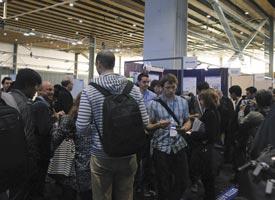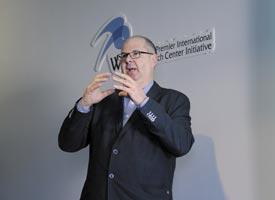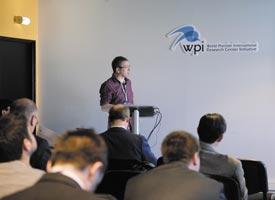

07/25/2016

On 2–6 May, researchers from the Advanced Institute for Materials Research (AIMR) shared their innovative contributions for a sustainable future at the European Materials Research Society’s (E-MRS) 2016 Spring Meeting in Lille, France. Researchers described advances in efficient solar electricity generation, high-capacity hydrogen storage and closed-loop energy systems to an attentive audience of global leaders from industry, government and academia.
The AIMR attended the E-MRS Spring Meeting together with a team of 30 members representing the World Premier International Research Center Initiative (WPI) and four of its research centers — the AIMR, the International Center for Materials Nanoarchitectonics (MANA), the Institute for Integrated Cell-Material Sciences (iCeMS) and the International Institute for Carbon-Neutral Energy Research (I2CNER) — including WPI Program Director Toshio Kuroki and AIMR Director Motoko Kotani. “In 2014, we found that joint participation in the E-MRS Spring Meeting was a very effective way to boost our presence, so we decided to attend it together again this year to get further exposure in Europe,” said Kotani.
The WPI program was launched in 2007 to create globally visible research centers in Japan that act as hubs for global brain circulation. One of the most effective ways to enhance the international presence of both the WPI program and the individual WPI centers is for centers to jointly participate in international meetings. The E-MRS 2016 Spring Meeting was the second time the four centers have jointly participated at the event in Lille and the fourth time they have jointly participated in international meetings.
The WPI team coordinated their attendance at the E-MRS 2016 Spring Meeting through three separate venues: an outreach activity in the exhibition hall; a one-day WPI symposium; and presentations by WPI researchers at other symposia.
The WPI exhibition booth was manned from 3 to 5 May. As in 2014, it contained furniture decorated with traditional Japanese designs to pique the interest of European researchers. Posters about the WPI program and the four centers were displayed on panels, and brochures were distributed to passers-by. The WPI outreach team was allotted a one-hour time slot to host an exhibitor workshop in the evening of 3 May, followed by a reception. Current president of the E-MRS, Luisa Torsi, vice presidents, Gilles Dennler and George Kiriakidis, and immediate past president, Thomas Lippert, attended the workshop. Many European researchers, including executive committee members of the E-MRS, joined the reception, and enjoyed chatting with members from the WPI centers over Japanese food and drinks. The informal gathering was a great opportunity to inform attendees about the WPI One-day Symposium to be held the next day, and it also served to increase the exposure of WPI in Europe.
On 4 May, Masaru Tsukada, administrative director of the AIMR, and Tomonobu Nakayama, administrative director of MANA, organized and chaired the WPI One-day Symposium, which explored the functional assembly of nanomaterials and their potential applications in electronics, energy and biology. The WPI Program and the individual WPI centers were first briefly introduced: Kuroki spoke about the objectives, achievements and future prospects of the WPI program and AIMR Director Kotani, iCeMS Director Susumu Kitagawa, I2CNER Director Petros Sofronis and MANA’s Nakayama introduced their respective centers.
The symposium proceeded with a scientific session of nine talks by WPI researchers and some invited and contributed talks by speakers from outside the WPI centers. In the morning session chaired by Tsukada, two AIMR principal investigators and two European professors invited by the AIMR presented their recent research on hydrogen materials and solar cells.

Andreas Züttel, a physical chemist at the Swiss Federal Institute of Technology in Lausanne (EPFL) and director of the Laboratory of Materials for Renewable Energy, described the key challenge for hydrogen technology today — the synthesis of hydrocarbons such as octane using only atmospheric carbon dioxide and hydrogen produced from renewable electricity. Achieving this recycle process will help resolve both environmental and energy demands. “Many hurdles must be overcome, for example, realizing large-scale electrolyzers, hydrogen storage and carbon dioxide adsorption,” said Züttel. “A well-controlled reaction between hydrogen and carbon dioxide that produces a specific product is needed. But if we can complete this process, we can realize a whole-energy conversion cycle that doesn’t produce any environmentally damaging discharges.”
Züttel is a long-time collaborator with AIMR Principal Investigator Shin-ichi Orimo, and the two are well known for their experimental demonstration of the highest-capacity hydrogen storage material. At the session, Orimo introduced recent studies into the synthesis of materials known as hydrides that offer a compact vessel for storing hydrogen. He described new high-density hydrides using a CrH7 pentagonal-bipyramidal anion, superionic conduction in BnHn-type hydrides with large cage-like units, and new all-solid-state rechargeable batteries, including lithium–sulfur batteries that have complex hydride electrolytes.

Next up was AIMR Principal Investigator, Seiji Samukawa, who described a technique for fabricating solar cells containing silicon quantum nanodots to improve the sunlight-to-energy conversion efficiency of the cells. His team used a biotemplate as an etching mask and a low-energy neutral beam to realize quantum dots that are defect free and smaller than 10 nanometers. Samukawa found the meeting particularly valuable as he was able to chat with collaborator Alain Fave, a photovoltaics researcher at the Lyon Institute of Nanotechnology, National Institute of Applied Sciences in Lyon (INSA-Lyon), and exchange information on recent progress in silicon solar cell experiments. “Participation at the E-MRS meeting has been a good opportunity to meet friends in Europe and consider future collaborations,” said Samukawa.
Fave gave a talk on the design, fabrication and characterization of ultrathin-film crystalline silicon solar cells that trap light efficiently. A major cost of silicon solar cell technology is the amount of silicon used per watt-peak. Reducing the thickness of the crystalline silicon layer, however, decreases the amount of light it can absorb. A critical area of research in the field is the development of technologies that can curb these optical losses. To achieve this, the Lyon Institute of Nanotechnology, within the framework of a European project led by the nanoelectronics research institute IMEC, recently fabricated photonic crystals and pyramidal nanostructures on the surface of the silicon layer by combining laser holographic lithography, reactive-ion etching, inductively coupled plasma etching and chemical etching. “These are the first steps toward developing a future generation of photonic-crystal-assisted solar cells,” Fave said. “We hope it will lead to the realization of high-efficiency solar cells.”
AIMR researchers also gave oral and poster presentations at other symposia organized at the E-MRS. Alexander Shluger, a professor at the Department of Physics and Astronomy and the London Centre for Nanotechnology, University College London, and a principal investigator at the AIMR, presented a theoretical study into the effect of excess electrons in oxides on the creation of Frenkel defects, in which an atom is displaced from its lattice position to an ‘interstitial’ site lying between lattice points. In particular, Shluger’s calculations indicate that excess electrons injected from electrodes can be trapped in deep states in amorphous silicon dioxide and hafnium dioxide (HfO2) and form quasiparticles known as polarons and bipolarons. The formation of bipolarons facilitates the formation of Frenkel defects in these materials. In a poster session, Moloud Kaviani, an AIMR research associate in Shluger's group, presented related theoretical research with respect to intrinsic electron trapping in amorphous HfO2. These results are important for understanding dielectric breakdown mechanisms in electronic devices and conductive filament formation in resistive random-access memory cells employing silicon and hafnium dioxide.
Two research associates from the AIMR group led by Principal Investigator Ali Khademhosseini — Sahar Salehi and Majid Ebrahimi — shared their work on engineering muscle tissue in the biomaterials session. And Akio Higo, an assistant professor from Samukawa’s group, presented research into the room-temperature operation of gallium arsenide quantum nanodisk light-emitting diodes fabricated using a technique called dry nanoscale etching and regrowth by metal organic vapor-phase epitaxy. “I really enjoyed this joint participation at the E-MRS meeting and had many valuable interactions, which I’ve not experienced at conventional conferences,” said Higo.